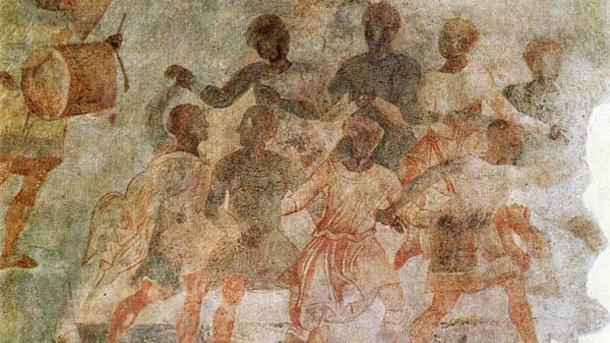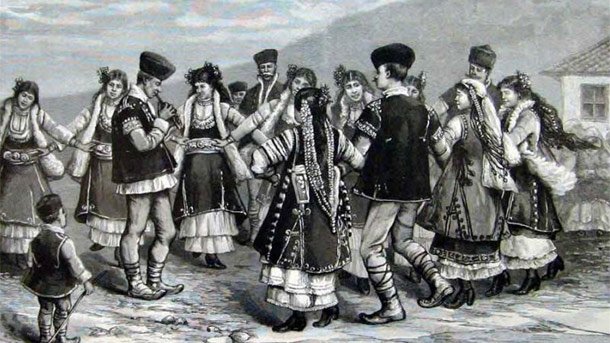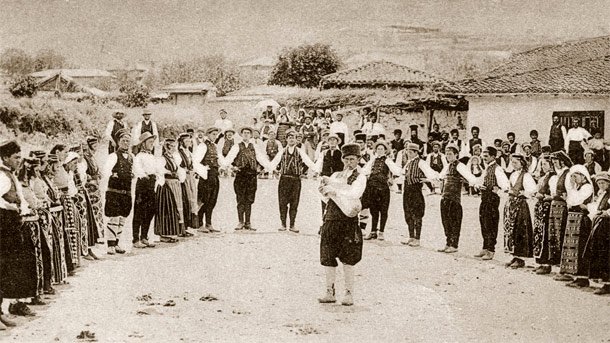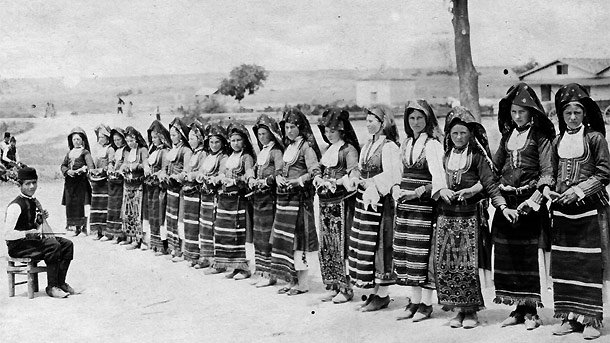Colorful, crowded and the center of merriment, the traditional horo chain dance has for centuries been part of Bulgarian holidays. Even in the days of computer technology, interest in the most popular traditional dance has not subsided. The number of clubs for folk dances in this country has been steadily on the rise, as an alternative to the fitness craze among younger generations. It is no secret that in a dozen countries of the world there are groups that study and present Bulgarian dancing folklore. Many foreigners discover Bulgaria through the magic of the traditional horo dance. In Folk Studio today we present to you the characteristics of the folk dance and invite you to listen to horo songs and instrumental dancing melodies.

© Photo: badamba.info
The word horo derives from the Greek horos, meaning a dance with singing performed by a group. The ancient Greeks believed that man had learned how to dance from the gods who practiced dancing as a divine hobby. The first mention of Bulgarian folk dances, though negative, is found in church literature. In 10 c. the Bulgarian ecclesiastical writer Prezviter Kozma wrote: „Those are not genuine Christians, who with rebecs and with rabid dancing and singing drink wine, believe in dreams, encounters and in various Satan’s teachings.”
In the first half of 14 c. Nicephorus Grigoras described his trip in the western Bulgarian province of Strumitsa. The Byzantine writer and scholar recounts that the young boys and girls after leaving church gathered for singing and horo dancing together. An old fresco in a church from the late 16 c. in the village of Arbanasi, Central Bulgaria, depicts a female horo dance with the typical interlacing grip. As these examples make clear, the energetic Bulgarian dances remained an integral part of community life of Bulgarians centuries after the adoption of Christianity despite the colossal efforts of the church to eliminate the influence of pagan folklore. Today this seems a bit strange because there is hardly an important orthodox Christian feast that could go without long chain dances. There are even present-day local gatherings held after church service in close proximity to churches and monasteries.

© Photo: archive
According to the definition a horo is a collective dance played in a circle, a chain or in a short straight row. The classification of horo dances is made as per different traits – there are male and female horo dances, straight and curved, open and closed ones etc. Some horo dance names speak about the association of dances with different animals – the Bear’s Horo, Hare’s Play, The Horse Horo, the Lame Dog Horo etc. These names have most probably survived from ancient cults and rituals that have lost their original religious meaning. There is a large group of horo patterns that recreate labor activities and this is displayed in the names of dance steps and gestures – chopping, hoeing, rowing. Given that not all movements can be copied literally, they are often stylized. There is a horo dance that stylizes the process of making yoghurt with the use of an ancient technology.

© Photo: lostbulgaria.com
There is however a different interpretation of the Bulgarian horo dances and it is about their sacral meaning. One example is the dance How Peppers are Planted. It is played during the culmination point of the wedding ritual. The feast went on at the wedding table but the newlyweds were sent to their wedding chamber. The door between them and the guests at the wedding was closed but guests still took part in the mystery of the first night of matrimony. As tradition required the young couple would for the first time be on their own as a husband and wife. Outside the room their relatives played the horo How Peppers are Planted, a dance that was associated with both the actual work in the garden and the pattern of the sexual act. As a wish for fertility of the new family, the Hare’s Dance was often performed.

© Photo: lostbulgaria.com
Once upon a time the festive horo dances were an occasion where young people could meet and where future mothers-in-law could take a look at girls and select from among them for their sons. Dressed up in their new clothes, both young and old flocked to the village square where horo dances were played for hours. Their rhythmic patterns are different in Bulgaria’s diverse folklore regions. However there were common principles that were never broken. As with all levels of patriarchal society, horo dancing had its own hierarchy. The first to join and lead the dance were married men followed by young unmarried men. Very often brides and girls danced in a separate row.
Hierarchy was also present in the mixed type of horo. It was inadmissible for girls and boys to hold hands. So, special kerchiefs were used to form the chain.
There is an interesting ritual in some parts of Bulgaria attesting to the social function of horo dancing. In the past the solemn mass on St. George’s Day was followed by a “led” horo dance, a straight row led by the most experienced dancer in the community. In his right hand the leader held a newly born baby and circled the village square several times this way to then hand the baby over to his mother. She in turn, would give him a bowl with wine grateful for the introduction of her baby to the community. This dance was held with all babies born throughout the year.
Researchers contend that some horo dances are part of sophisticated music or dramatic performances. The circular or closed horo dances could be traced back to the cult for the Sun. Some even look for esoteric layers keeping centuries-old secrets. In this vein of thought the closed horo resembles the movement of planets around the Sun, because its direction is counter-clockwise. In this way the dance pattern is a scale model of the solar system. The synchronization with the vibrations of the Universe was a source of great psychological, physical and spiritual power for dancers. Well, I guess anyone who has danced a horo would agree with the assumption of its invisible power and magic.
Translated by Daniela Konstantinova
The feast of the Annunciation (Blagoveshtenie in Bulgaria) is a holy day , a symbol of God’s infinite mercy to people and especially to women, blessed to bear new life, but also an embodiment of the eternal human longing for something better in the..
Clocks and bells will ring out in the center of Stara Zagora on Saturday, when the city will host the XXIV Masquerade Games Festival . The event will start with a traditional parade of participants. Attractive babugers, araps, old men and other..
Today marks the 88th anniversary of the birth of remarkable Bulgaria folk singer Nadka Karadzhova . Born on March 14, 1937 in the then Pazardzhik village of Trivoditsi (today - Plovdiv region), she is a descendant of an old musical family. At the age..

+359 2 9336 661
